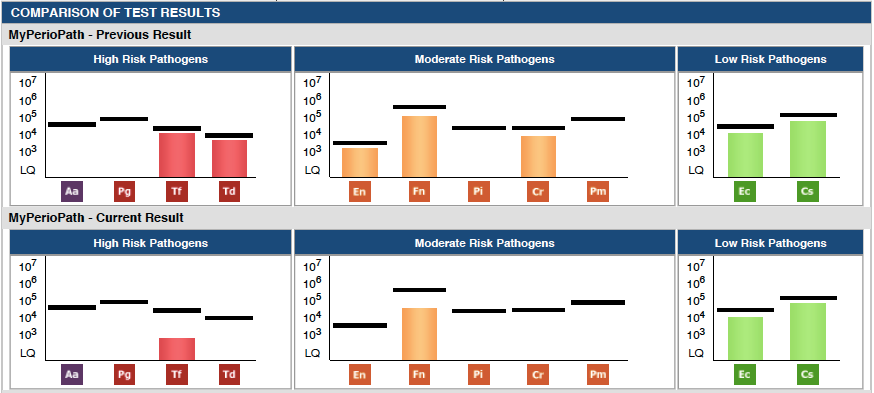
Challenge: A periodontal patient of record is diagnosed with active periodontal disease. Therapy is needed to achieve a healthier oral state; however the patient has uncontrolled diabetes combined with poor home care that may be contributing to the patient’s oral health status.
Background: A female patient of record, age 48, presented for periodontal maintenance on 11/19/2018. Upon periodontal assessment, the patient exhibited oral inflammation with bleeding, moderate calculus deposits and generalized 4-6 mm periodontal probe depths. The patient’s homecare is lacking: she does use Peridex on a daily basis, though is not very diligent regarding other home care instructions. For example, the patient has PerioProtect® trays, but has not established routine use, and flossing is on and off. Being a diabetic with poor blood sugar control, high blood pressure, as well as high cholesterol also complicates the periodontal disease state.
Solution: MyPerioPath® analysis was performed from a saliva specimen secured on 11/19/2018. A treatment plan of scaling and root planing was applied to address the periodontal pathogens evoking the patient’s periodontal disease. Doxycycline, 100mg bid for 8 days, was administered per the doctor’s recommendation. Supplements such as Vitamin D and CoQ10 were discussed, along with the instruction of daily use of the PerioProtect® trays. Home care instructions and the need for compliance were emphasized. The Systemic Effects of Oral Pathogens, page two of the MyPerioPath® report, helped in educating the patient that there were several bacteria that could be complicating her diabetic control. The patient was scheduled for a post therapy evaluation and the MyPerioProgress® test on 1/24/2019. I felt confident of the patient’s understanding and will for compliance, not just for her periodontal health, but for her overall health as well.
Resolution: After therapy and a period of time for healing, the MyPerioProgress® post-therapy specimen was collected on 1/24/2019. Upon periodontal evaluation after therapy, the tissue appeared to be healthier. There was a dramatic reduction of calculus and decrease in bleeding on probing. The patient’s overall skin appearance was improved and she indicated better control of her blood sugars.
This case highlighted the need to use OralDNA® tests more often so we can have an objective measurement of what the therapy achieved. The patient appreciated seeing the more dramatic changes in the biofilm. She realizes her periodontal status is delicate and it can impact her overall health. We will continue to monitor her compliance and administer another MyPerioPath® when her disease state relapses.

For more information on how to become an OralDNA Provider – scan HERE: 
